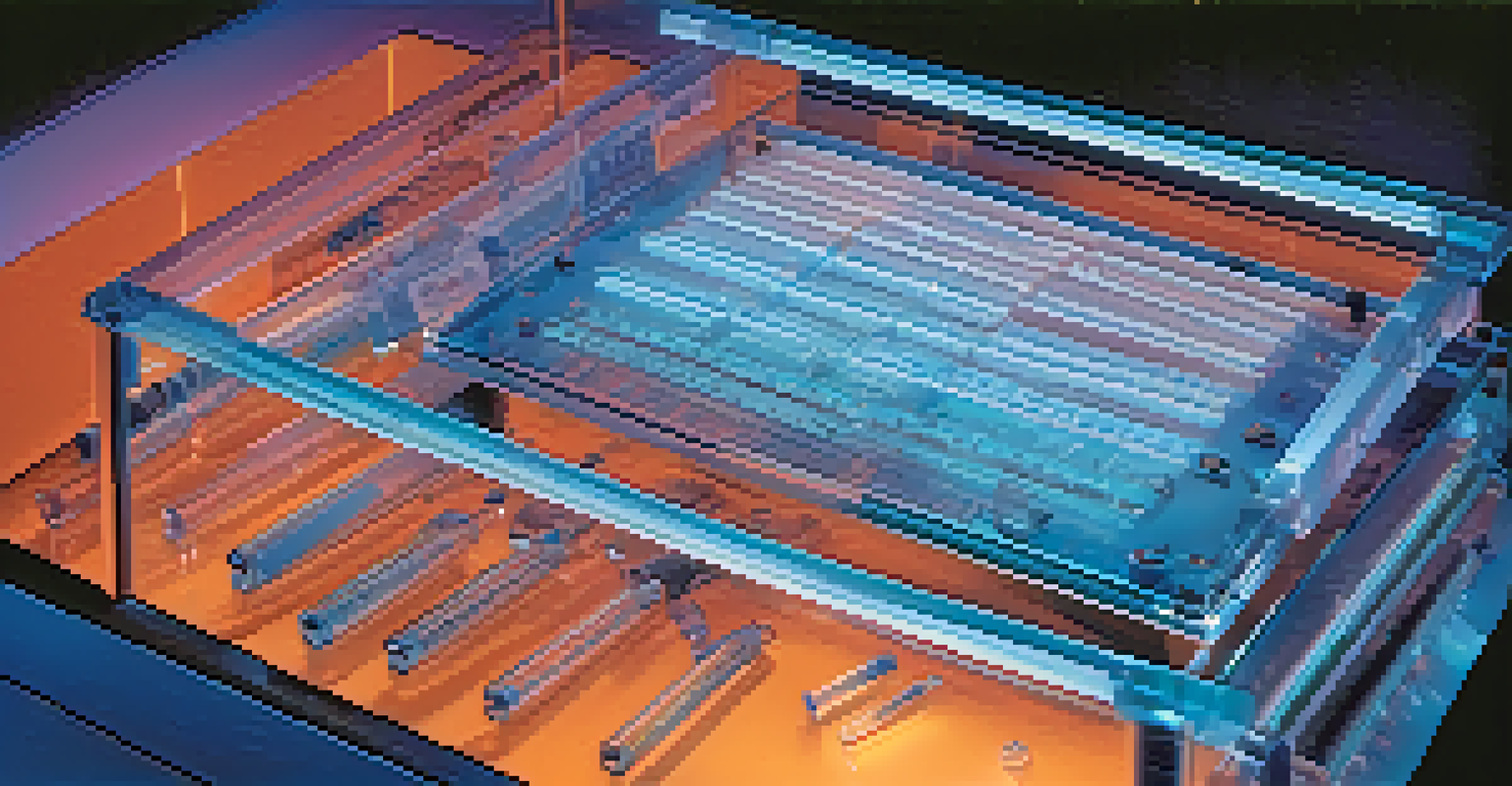Molecular Genetics: Techniques for Analyzing Genetic Material

Introduction to Molecular Genetics and Its Importance
Molecular genetics is a branch of biology that focuses on the structure and function of genes at a molecular level. This field has become increasingly important as we seek to understand how genes contribute to health and disease. By analyzing genetic material, scientists can uncover the underlying mechanisms of various biological processes.
The great thing about DNA is that it has the ability to change, to evolve, and to provide insight into the future of life itself.
In recent years, advances in molecular genetics have opened doors to personalized medicine, allowing treatments to be tailored to individual genetic profiles. This not only improves efficacy but also minimizes potential side effects. Understanding molecular genetics is crucial for both researchers and healthcare professionals.
As we delve deeper into the world of molecular genetics, we will explore various techniques that have revolutionized our ability to analyze genetic material. Each method has its unique applications and benefits, which we’ll discuss in detail.
Polymerase Chain Reaction (PCR): Amplifying DNA
One of the most significant breakthroughs in molecular genetics is the Polymerase Chain Reaction (PCR). This technique allows scientists to amplify small segments of DNA, making it possible to analyze even the tiniest samples. Imagine trying to find a needle in a haystack; PCR acts like a spotlight, illuminating the DNA you want to study.

PCR works by repeatedly cycling through temperatures that allow the DNA to denature, anneal, and extend. This process can create millions of copies of the target DNA in just a few hours, enabling detailed analysis. Its speed and efficiency make PCR an invaluable tool in research, clinical diagnostics, and forensic science.
Molecular Genetics Revolutionizes Medicine
Advancements in molecular genetics enable personalized medicine, tailoring treatments to individual genetic profiles for improved efficacy and reduced side effects.
The versatility of PCR means it can be adapted for various applications, including detecting genetic mutations, identifying pathogens, or cloning genes. As we continue to explore techniques in molecular genetics, PCR stands out as a foundational method that has transformed how we study genetic material.
Gel Electrophoresis: Separating DNA Fragments
Once DNA has been amplified using PCR, the next step often involves separating the fragments to analyze their size and composition. This is where gel electrophoresis comes into play. Think of gel electrophoresis as a race for DNA fragments; smaller pieces move faster through the gel than larger ones.
Genetics is the key to unlocking the mysteries of life, not just in understanding diseases, but also in enhancing the quality of our existence.
During this process, an electric current is applied to a gel matrix containing the DNA samples. As the current flows, the fragments migrate towards the positive electrode, with their speed influenced by their size. This allows researchers to visualize and compare different DNA samples based on the pattern of bands formed.
Gel electrophoresis is not only essential for checking the success of PCR but also aids in various applications like DNA fingerprinting and genetic mapping. By understanding how to interpret the results, researchers can glean crucial information about genetic variations and relationships.
DNA Sequencing: Unlocking Genetic Codes
DNA sequencing is a technique that determines the precise order of nucleotides in a DNA molecule. It’s akin to reading a book; by understanding the sequence, scientists can decode the genetic instructions that govern an organism's development and function. This process has become a cornerstone of molecular genetics.
There are several methods of DNA sequencing, but one of the most widely used is next-generation sequencing (NGS). NGS allows for the rapid sequencing of large amounts of DNA, making it possible to analyze entire genomes in a matter of days. This revolutionary advancement has accelerated research in genetics, genomics, and personalized medicine.
PCR and Gene Editing Transform Research
Techniques like PCR and CRISPR-Cas9 provide powerful tools for amplifying DNA and editing genes, significantly enhancing our ability to study and manipulate genetic material.
By identifying mutations and variations in DNA sequences, researchers can gain insights into genetic diseases and develop more effective treatments. The ability to sequence DNA quickly and accurately has opened up new frontiers in our understanding of genetics, paving the way for groundbreaking discoveries.
CRISPR-Cas9: A Tool for Gene Editing
CRISPR-Cas9 has taken the world of molecular genetics by storm, offering a powerful way to edit genes with remarkable precision. This technology can be likened to a pair of molecular scissors, allowing scientists to cut DNA at specific locations and make targeted changes. The implications for research and medicine are immense.
The CRISPR-Cas9 system was originally discovered in bacteria as a defense mechanism against viruses. Researchers harnessed this natural process to create a tool for gene editing, enabling them to knock out genes, insert new sequences, or correct mutations. This versatility has made CRISPR a game-changer in genetic engineering.
From agricultural improvements to potential cures for genetic disorders, the applications of CRISPR-Cas9 are vast. However, ethical considerations surrounding its use, particularly in human embryos, continue to spark debate, highlighting the need for responsible research and oversight in this rapidly advancing field.
Microarrays: Analyzing Gene Expression
Microarrays are a powerful tool used to analyze the expression levels of thousands of genes simultaneously. Imagine a bustling city with countless streets; microarrays allow researchers to map out which genes are 'active' at any given time. This technique provides insights into how genes respond to various conditions, such as disease or environmental changes.
In a typical microarray experiment, DNA probes are attached to a solid surface, and labeled RNA or DNA samples are hybridized to these probes. The intensity of the signals from the hybridized samples reflects the expression levels of the corresponding genes. This high-throughput approach enables researchers to identify patterns and relationships in gene expression.
Future Innovations in Genetics Await
Emerging technologies such as single-cell sequencing and AI integration promise to deepen our understanding of genetics and revolutionize healthcare and agriculture.
Microarrays have numerous applications, including cancer research, where they help identify biomarkers for diagnosis and treatment. By understanding gene expression profiles, scientists can develop targeted therapies and improve patient outcomes, showcasing the impact of this technique on medicine and biology.
Conclusion: The Future of Molecular Genetics Techniques
As we look to the future, the techniques of molecular genetics will continue to evolve and expand our understanding of genetic material. Innovations such as single-cell sequencing and advanced bioinformatics are on the horizon, promising even deeper insights into the complexities of genetics. The journey of discovery in this field is far from over.
The integration of artificial intelligence in analyzing genetic data is also gaining momentum. These advancements will not only enhance our ability to process vast amounts of information but also lead to more precise predictions and analyses. The potential for breakthroughs in genetic research and personalized medicine is immense.

Ultimately, the techniques we’ve explored in this article are just the beginning. As scientists continue to push the boundaries of molecular genetics, we can anticipate exciting developments that may transform healthcare, agriculture, and our understanding of life itself.